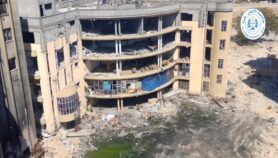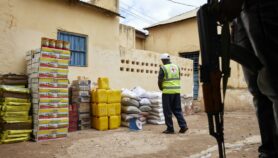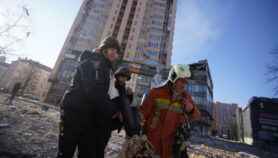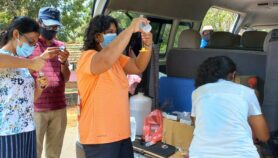By: Imogen Mathers
Send to a friend
The details you provide on this page will not be used to send unsolicited email, and will not be sold to a 3rd party. See privacy policy.
Politicians wrangle over explosive weapons in cities but mapping efforts can hasten clean-up, says Thomas Nash.
“There’s a game children play here — it’s called one, two, three, airstrike,” the BBC’s Gabriel Gatehouse reported from Yemen earlier this month (10 September). Gatehouse was covering the Saudi-led air strikes on the Yemeni capital Sana’a — strikes intended to oust the Houthi rebels controlling the city. UN officials say bombs have hit schools, homes and hospitals, in breach of international humanitarian law. In the six months since the Saudi campaign began, over two thousand civilians have died, 25,000 have been injured, and about 1.5 million people have fled their homes.
To find out more about the humanitarian impact of this kind of urban warfare and routes to reducing harm to civilians, I spoke to Thomas Nash, director of Article 36, a UK-based weapons monitoring and advocacy organisation.
Firing or dropping explosive weapons on heavily populated areas is a tactic used in many modern wars — increasingly so as conflict becomes more urbanised and asymmetrical: wars in Libya, Syria and Yemen have seen rebel groups using guerrilla tactics against massive state air power. Around 90 per cent of the victims of explosive bombing in cities are civilians.
The legacy of cluster munitions technology can last for decades, Nash tells me. This is because they explode mid-air into hundreds of sub-munitions or ‘bomblets’. If these fail to detonate they can lie dormant for years until people disturb them. He says that cleaning up after cluster bombs is a painstaking process fraught with obstacles — and that organisations trying new ways to tackle this problem need support.
Thomas Nash, director of Article 36, explains the impact of cluster bombs on human beings and why systematic clearance operations are so vital.
The legacy of US strikes on South-East Asia shows the deadly impact of unexploded cluster bombs. In Cambodia, Laos and Vietnam, “there are still … farmers hoeing their land, hitting one of the cluster bombs dropped in the ‘60s and ‘70s, and being killed,” Nash says. People gathering firewood are also at risk. But perhaps the most devastating impact is on children, by nature curious and inquisitive.
So what can be done? Clearly, getting more countries to sign and enforce the 2010 Convention on Cluster Munitions is vital. Beyond that, there’s the slow process of cleaning up the deadly trail. This in itself can be politically controversial, Nash says.
“It’s hard to know where to prioritise scarce resources for clearance,” he explains. And competition between local authorities for funding can be severe.
Locating the unexploded bombs is also a challenge. Even getting hold of maps and data showing where they have been dropped can be difficult. This is partly because governments may deny ever having used them.
Thomas Nash, director of Article 36, analyses the role of the media monitoring in tracking where cluster munitions have been used.
One solution is to monitor media coverage of conflicts. An organisation called Action On Armed Violence has been doing “extensive and impressive monitoring” of explosive weapons use, Nash tells me, by drawing on analysis of English language media reports.
“It’s very difficult to gather comprehensive data about what’s happening in conflict, so what you can do is to develop a snapshot of the problem.”
The approach gives “a reasonable set of data that can be used to inform the policy of governments”. A UN meeting in Austria this week (21-22 September) sought to rally countries to the cause of reducing bombing in populated areas. But, while politicians argue, monitoring and clearance work will be vital to helping those living in today’s war zones recover once conflict is over.
Imogen Mathers is producer/assistant editor at SciDev.Net. @imogenmathers
References
Robert Perkins State of Crisis: Explosive Weapons in Yemen (Action On Armed Violence and UN Office for the Coordination of Humanitarian Affairs, September 2015)














